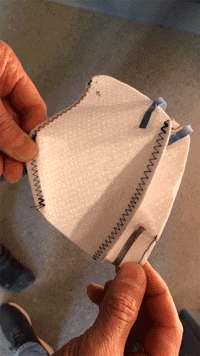On a quiet day this spring, three homes in Stockholm hummed with the sound of sewing machines run by McKinsey designers, who were racing to create a new prototype for what had become one of the most vital products amid the coronavirus pandemic: face masks.
“We had five days,” says Marcus Heneen, a McKinsey design director. That was the turnaround time a global air-filtration company gave the team to create the optimal face mask design for distribution at a local hospital.
Under typical circumstances, such an aggressive deadline might feel impossible. Design collaboration often involves lengthy processes across several stakeholders. “But in this case, everything the CEO asked for happened within minutes,” says Hans Nyström, an associate design director. “It showed how powerful the value of design can truly be when elevated to the executive level.”

Three McKinsey Design colleagues took on the challenge, each of whom had prior textile and personal protective equipment design expertise. “Within a few hours of the request, we had each received all the needed materials,” adds Frida Ahremark, a senior designer. Then, it was time to get to work.
Given the global shortage of face masks at the start of the outbreak—and the growing preference for more local production—the air-filtration company decided to repurpose its Sweden-based production line to make masks. But the line couldn’t perform methods typically used to create them, such as ultrasonic welding or heat forming technologies. “Instead, the masks would have to be sewn in order to be compatible with the company’s machinery,” says Hans.

Working away from each other in their own homes—a radical change from how they had ever worked before—Marcus, Frida, and Hans set up their sewing machines and cutting tables and began working concurrently on different parts of the prototypes. “This allowed us to conquer the various elements of the design quickly,” says Marcus. As he focused on the nose clips, for instance, Frida perfected the head strap, and Hans worked on the shape of the mask, which the designers wanted to be one size fits all. “We had to take into account aspects like a tight seal to prevent leakage, comfort against the skin without causing humidity from air exhalation, and enough flexibility in the fabric to allow for jaw motion,” explains Frida.
For Marcus, Hans, and Frida, this first attempt at remote team work was a challenge that delivered worthwhile lessons. “Design is something so tactile,” says Frida. “We’re all so accustomed to being together in the same room to ideate, experiment, touch, and see.”
But to their own surprise, they found that while physically apart, the ability to solve a complex task together was still feasible. Much of that was a result of agile workstreams and having the right technologies in place.
Through video conference calls and couriers delivering their respective prototypes to each other across the city, the three designers tested different hypotheses and iterated fast—sometimes sewing several design iterations in just an hour. The designers then tested their creations on family members. “Thankfully, between all of us, we had a wide enough sample pool across genders and face shapes,” says Hans.

By the end of the five days, the team had hand-sewn 45 prototypes to share with the air-filtration company. After surgeons and nurses from the local hospital evaluated the masks in a testing facility for several hours at a time, five million were ordered for the immediate future as well as for post-pandemic use.
To complete production on the sizeable order, the company hired more than 100 recently laid-off people to manually sew the masks. Within two months, 100,000 masks were manufactured for the hospital with production ramping up to 200,000 pieces a week.
“The impact has been beyond anything we could have imagined,” says Marcus. “Not only has it led to the safeguarding of lives and livelihoods, it has become an entirely new business unit for the company going forward.”